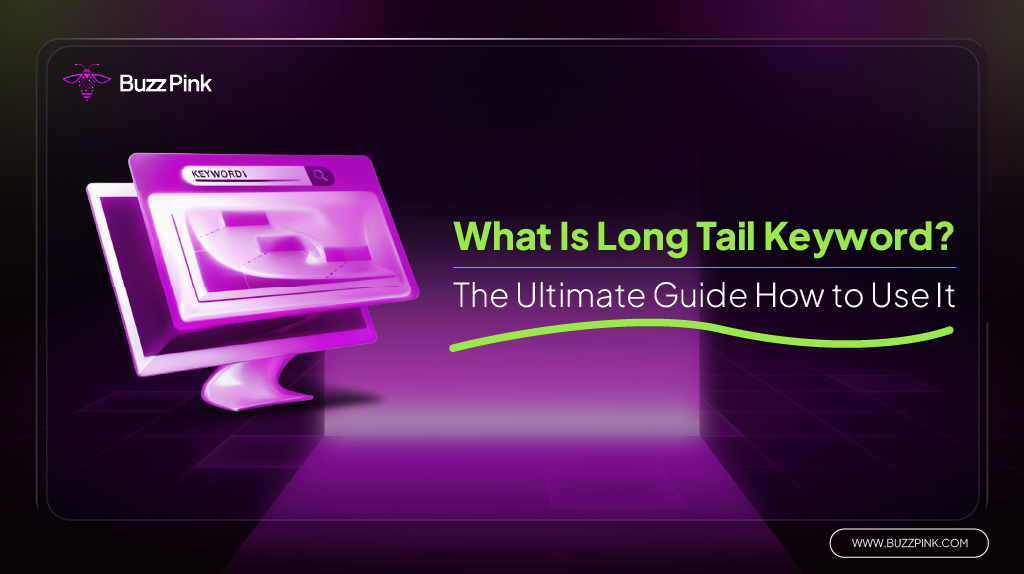If you type a short word like “cellphone” into a search engine, it’s called a short-tail keyword. A long-tail keyword, on the other hand, is one that is more specific, such as “cellphone with a good camera under $300”.
Although long-tail keywords are rarely used by many users, those who do are more likely to know what they want. Aside from that, there are numerous advantages, which we will discuss one by one.
What Is Long Tail Keyword
 Long-tail keyword is longer and more specific word combinations than standard keywords. Long-tail keyword is typically composed of three or more words, but the most important aspect is that they are more precise. As a result, people who use these keywords typically have a specific intent, such as wanting to buy a product, seeking detailed information, or meeting a specific need.
Long-tail keyword is longer and more specific word combinations than standard keywords. Long-tail keyword is typically composed of three or more words, but the most important aspect is that they are more precise. As a result, people who use these keywords typically have a specific intent, such as wanting to buy a product, seeking detailed information, or meeting a specific need.
Furthermore, long-tail keywords have lower search volumes than short-tail keywords. However, even though they are smaller, they are often easier to win because there is less competition. In other words, long-tail keywords enable small or new websites to compete with larger websites by narrowing their target audience and increasing the quality of visitors they receive.
Why Using Long Tail Keywords Is Important In SEO
 Long-tail keywords are important in SEO because they help you rank higher on Google. Large websites frequently compete for broad keywords, but specific keywords are frequently overlooked.
Long-tail keywords are important in SEO because they help you rank higher on Google. Large websites frequently compete for broad keywords, but specific keywords are frequently overlooked.
Furthermore, people who search for long-tail keywords usually have a strong intent, such as wanting to buy a product or find an immediate solution. As a result, the resulting traffic is not only significant, but also has a higher potential for conversion.
Read More: What Is An SEO Agency? Key Services and Benefits of Working with One
When many long-tail keywords with similar search intent are combined, the total search volume can be quite high. So, even if a single keyword is insignificant, combining several can be extremely profitable.
Finally, long-tail keywords can help websites appear in AI answers like ChatGPT and Google AI. Because AI questions are frequently long and conversational, content containing long-tail keywords is more likely to appear.
The Differences Between Short, Mid, and Long Tail Keywords
“Handphone” is an example of a short-tail keyword. This term is frequently searched for, but it is also extremely competitive. Mid-tail keywords fall in the middle. They are still somewhat broad, but more specific than short-tail keywords. For example, “Samsung phone.” The searchbroad but volume and competition levels are both moderate.
Long-tail keywords are the most specific. For example, “Samsung smartphone with 108MP camera costs 5 million.” Despite the low search volume, visitors are more targeted. The distinction between mid-tail and long-tail keywords is not always clear. As a result, we must evaluate them using criteria such as specificity, search volume, and competitiveness.
In essence, short-tail keywords are broad but competitive, mid-tail keywords are moderate, and long-tail keywords are narrow but focused. Our SEO strategy allows us to use all of these keywords.
How to Rank High by Utilizing the Long Tail Method: Step by Step
 There are several steps to take in order to rank high on Google for long-tail keywords. Essentially, you must select appropriate keywords, write useful content, and maintain website quality. Let us now go through each of these steps one by one.
There are several steps to take in order to rank high on Google for long-tail keywords. Essentially, you must select appropriate keywords, write useful content, and maintain website quality. Let us now go through each of these steps one by one.
Establish Keyword Clusters
First, we define keyword clusters. For instance, “cheap Nike running shoes” can be paired with “cheap Nike shoes for middle school students” or “cheap original Nike running shoes.” This allows us to target multiple keywords simultaneously.
If these keywords have the same search intent, we can group them into a single article or page. As a result, visitors using a variety of search terms can still find our page. The more clusters you master, the better your chances of attracting traffic from various search types.
Target the Keyword Precisely
The second step is to place keywords in the appropriate locations. Examples include the article title, subheadings, meta description, and images. However, do not divide all keywords into separate articles. If there are similar keywords, simply put them in one article. This is more efficient and remains relevant.
By targeting keywords precisely, it’s easier for Google to recognize the content of your page and display it to the right people.
Useful Contents for Users
The content we create must be truly useful to users. Don’t simply stuff keywords. When people search for “cheap Nike running shoes,” they most likely want to know the price, where to buy them, and the quality. As a result, our articles must clearly address all of these questions. Useful content keeps visitors interested, and Google will recognize our pages as high-quality.
Slip Keywords Naturally, No Stuffing
Keywords are useful, but don’t overuse them. For example, repeatedly writing “cheap Nike shoes, cheap Nike shoes, cheap Nike shoes” will make your content appear unprofessional. Google can now detect keyword stuffing. The best approach is to incorporate keywords naturally, as in a casual conversation. This will make it easier to read while remaining SEO-friendly.
Pleasant Pages Through Good UX
UX (User Experience) refers to the user experience when visiting our website. People will feel at ease if the website is user-friendly, fast, and has a clean layout. People are more likely to stay on pages that are visually appealing and easy to navigate. This is a positive indication for Google. So, instead of focusing solely on keywords, make the website more user-friendly.
Read More: Web Design and SEO: Reasons Your Website Needs Both
Use Schema Markup Depending on Google’s Algorithm
Schema markup is extra code that helps Google understand the content on our pages. As an example, consider the FAQ schema for questions and answers. If the schema is used correctly, your website can appear more appealing in search results by including star ratings, prices, or popular questions. This increases the likelihood of users clicking on your website.
Focus on Internal Links
Internal links are links between pages on our website. For example, from an article about “cheap Nike shoes,” we link to one about “how to select good running shoes.”
Internal links allow visitors to navigate more pages and help Google understand the structure of our website. Internal links, when done properly, can also help other pages rank higher.
Advantages of Utilizing Long Tail Keywords
Using long-tail keywords has numerous benefits over focusing solely on short-tail keywords. They can help even small websites maintain their chances of appearing in search results. As a result, this strategy is widely used by business owners seeking to compete with the major players on the internet.
Easier to Rank High on Search Engines
Long-tail keywords rank higher on Google’s top pages due to their low competition. Even small websites can compete with larger ones if they concentrate on long-tail keywords. This makes long-tail keywords ideal for new businesses or personal blogs without a strong reputation.
More Qualified Traffic
Traffic from the long tail is typically more prepared to take action, such as purchasing a product or signing up for a service. As a result, even though the number is small, the quality of the visitors is higher. In some ways, the long tail helps connect websites to the people who actually need them.
High Collective Search Volumes When Clustered
When many long-tail keywords are combined (clustered), the total search volume can be significant. As a result, the outcomes have the potential to attract a large number of visitors. This strategy allows a single article to reach a large number of different search variations at the same time.
More Likely to Show Up on Google’s AI Responses
Because AI systems such as ChatGPT and Google AI frequently answer long-tail queries, content containing long-tail keywords is more likely to appear there. This allows websites to receive additional traffic not only from Google, but also from AI-powered platforms. This is increasingly important as the way people search for information is increasingly shifting towards AI.
Disadvantages of Utilizing Long Tail Keywords
However, there are some disadvantages to using long-tail keywords. Using long-tail keywords, like any other strategy, has advantages and disadvantages. As a result, understanding the risks is critical before committing to an SEO strategy.
Lower Traffic
Each long-tail keyword usually has a small search volume. Don’t expect to get thousands of visitors from a single long-tail keyword. However, the quality of these visitors is usually higher, as they are more deliberate from the start.
Time-Consuming Research
Finding long-tail keywords takes time because they must be extremely specific. Without sophisticated (and often expensive) SEO tools, the process can be time-consuming. As a result, finding the right keywords necessitates patience and a focused strategy.
Reduce Readability
If you force yourself to use long keywords frequently, your writing will become stiff and difficult to read. As a result, visitors may become bored and quickly leave the page. As a result, striking the right balance between SEO and reader comfort is critical.
Sometimes They Cannot Be Discovered
Sometimes keywords are so long that Google does not return any results. So being overly specific can make it difficult to find. In that case, optimization efforts may be futile because almost no one searches.
Conclusion
Long-tail keywords may appear insignificant, but when used correctly, they can be extremely powerful. They can help small websites compete by attracting more qualified visitors and improving their visibility in search results.
While there are some disadvantages, such as a low search volume and complex research, the benefits frequently outweigh these. If you’re serious about SEO, long-tail keywords should be an important part of your strategy.
Kamila Putri is a content strategist and digital marketing expert who helps brands craft messages that resonate and drive results. With a strong foundation in SEO, brand voice, and data-driven strategy, she has produced content that performs, whether it's optimized web copy, lead-generating campaigns, or conversion-focused messaging. At Buzz Pink, she applies this expertise to help clients grow through smart, search-focused digital strategies that engage, inform, and convert.


